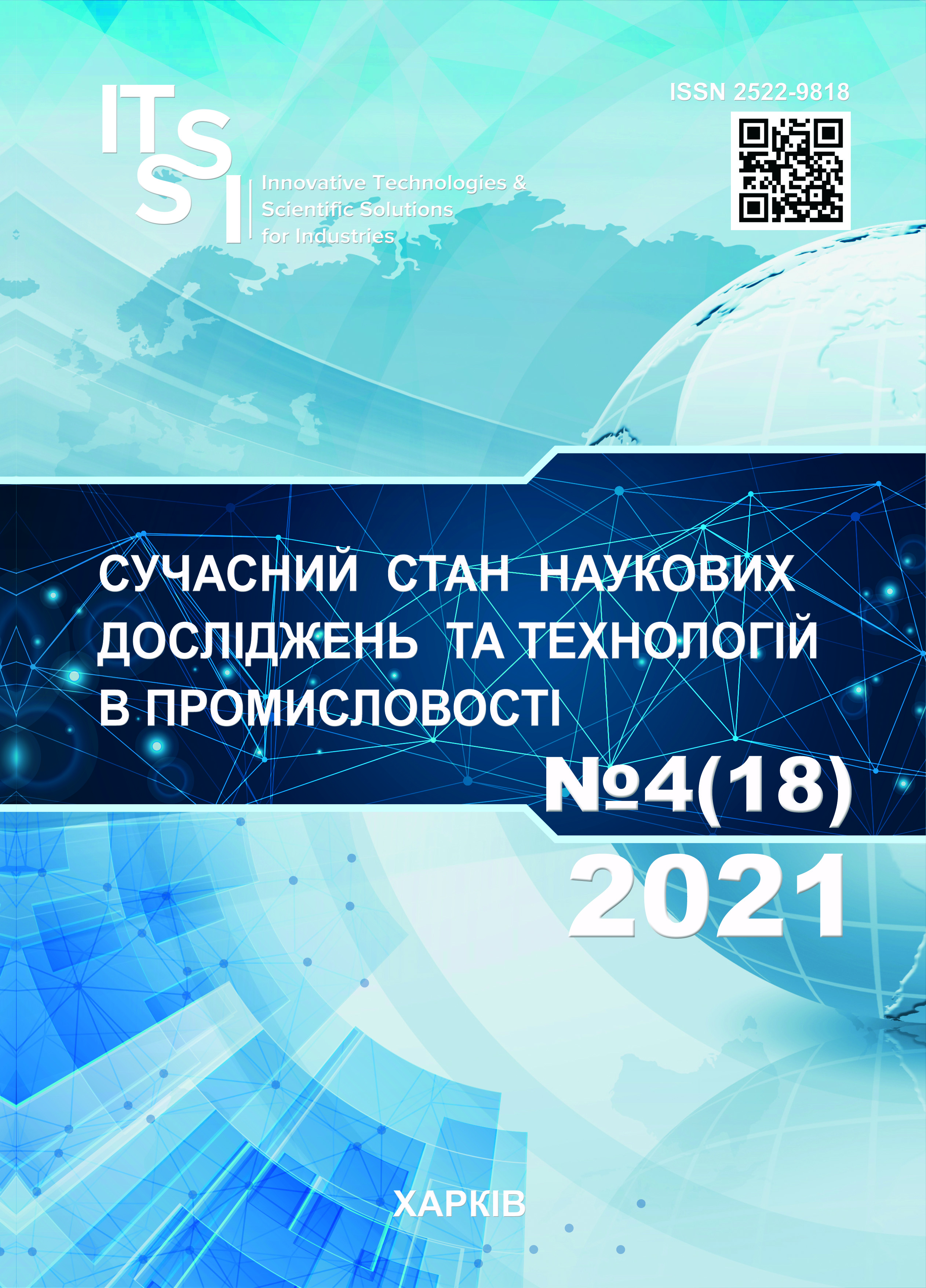IMPROVEMENT OF ROBOTIC SYSTEMS BASED ON VISUAL CONTROL
DOI:
https://doi.org/10.30837/ITSSI.2021.18.065Keywords:
visual control, making decisions, mobile robot, flexible embedded systemAbstract
The subject of research in the article is the use of adaptive visual control in flexible integrated robotic systems. The goal of the work is the integration of visual control facilities into automated control systems for transport and handling operations of flexible integrated production. The article solves the following tasks: analyze the application of visual control methods in robotics, consider methods for improving adaptive visual work control systems, formulate the basic requirements for adaptive visual control systems, and develop a control model for a mobile robot in the space of a flexible integrated production systems and computer vision systems. To solve the set tasks, the methods of set theory, methods of automatic control theory, and methods of the theory of image processing were used. The following results were obtained: the analysis of visual control systems was carried out from the point of view of solving the problems of flexible integrated systems of modern production; the adaptive visual control scheme was improved by introducing a declarative workspace model and a functional model of a flexible integrated system; the main requirements and tasks of adaptive visual control systems are formulated; considered the main stages of processing visual information and their practical implementation, including multi-zone workspaces; a model of visual control of a mobile robot in a flexible integrated production workspace has been developed; the practical tasks of managing mobile platforms have been solved. Conclusions: the use of adaptive visual control in a production environment will allow combining the elements of flexible integrated production distributed in space, providing monitoring, control and refinement of control processes in real time, the functioning of intelligent control tools, which will improve the quality of control processes.
References
Skitsko, V. (2016), "Industry 4.0 as the industrial production of the future" ["Industriya 4.0 yak promyslove vyrobnytstvo maybutnʹoho"], Investment: practice and experience, No. 5/20, P. 33–40.
Perks, A. (2006), "Advanced vision guided robotics provide “future‐proof” flexible automation", Assembly Automation, Vol. 26 No. 3, Р. 216–220. DOI: https://doi.org/10.1108/01445150610679759.
Graefe Volker, Bischoff Rainer. (1998), "Visual-Guided Intelligent Robots", Proceedings of Workshop on Machine Vision Applications", Chiba, Japan, P. 167–176.
Kowalczuk, Z., Wesierski, D. (2008), "Vision Guided Robot Gripping Systems, Automation and Robotics", JIntechOpen. DOI: 10.5772/6264.
Girish, G. Patil. (2013), "Vision Guided Pick and Place Robotic Arm System Based on SIFT", International Journal of Scientific & Engineering Research, Vol. 4, Is. 12, P. 242–248.
Devyaterikov, E., Mikhailov, B. (2013), "Mobile robot motion control system with visual odometer", Scientific and technical sheets of St. Petersburg State Pedagogical University, No. 5’(181), P. 103–108.
Leonard, S., Wu, K. L., Kim, Y., Krieger, A., Kim, W. (2014), "Smart Tissue Anastomosis Robot (STAR): A Vision-Guided Robotics System for Laparoscopic Suturing," in IEEE Transactions on Biomedical Engineering, Vol. 61, No. 4, P. 1305–1317. DOI: 10.1109/TBME.2014.2302385.
Tsymbal, O., Bronnikov, A. (2019), "Decision-making information technology for flexible integrated manufacturing", Innovative technologies and scientific solutions for industries, No. 2 (8), P. 105–112.
Nevliudov, I., Tsymbal, O., Bronnikov, A., Mordyk, O. (2020), "Internet of things for robotic projects", Innovative technologies and scientific solutions for industries, No. 3 (13), P. 58–64.
Tsymbal, O., Zamirets, M., Mordyk, O., Bronnikov, A., Kornilova, Y.(2020), "Intelligent methods of video surveillance: analysis of implementation methods" ["Intelektualʹni metody videosposterezhennya: analiz metodiv realizatsiyi"], Technology of instrumentation, No. 1, P. 35 – 40.
Nevliudov, I., Vladyslav Y., Omarov, M., Bronnikov, A., Liashenko, V. (2020), "Method of Algorithms for Cyber-Physical Production Systems Functioning Synthesis", International Journal of Emerging Trends in Engi-neering Research (IJETER), Vol. 8, No. 10, P. 7465 – 7473. DOI:10.30534/ijeter/2020/1278102020
Tsymbal, A., Bronnikov, A. (2013), "Modeling of adaptive decision-making in robot ICS" ["Modelirovaniye adaptivnogo prinyatiya resheniy v ISU robotom"], Bulletin of BSTU. V.G. Shukhov, No. 4, P. 173–176.
Bronnikov, A., (2016), "Adaptive visual control of a production agent" ["Adaptivnoye vizual'noye upravleniye proizvodstvennym agentom"], Technology of instrumentation, No. 3, P. 3–6.
Kuleshov, S. (2003), "Application of hidden Markov models for face recognition", ["Primeneniye skrytykh markovskikh modeley dlya raspoznavaniya lits"], KurSU, Kurgan, P. 40.
Reddy, R. (2016), "Canny Scale Edge Detection" , IJETT, P. 4.
Yousefi, J. (2011), "Image Binarization using Otsu Thresholding Algorithm", University of Guelph, P. 7.
Lowe, D. (2004), "Distinctive Image Features from Scale-Invariant Keypoints", International Journal of Computer Vision, P. 28.
Hartley, R., Zisserman, A. (2001), "Multiple View Geometry in Computer Vision", Cambridge University Press, P. 12.
Vertegaal, Roel (2008), "A Fitts Law comparison of eye tracking and manual input in the selection of visual targets", Proceedings of the 10th international conference on Multimodal interfaces, P. 241–248.
Gegenfurtner, K. (2007), "A comparison of localization judgments and pointing precision", Journal of Vision, P. 11.
Downloads
Published
How to Cite
Issue
Section
License
Copyright (c) 2021 Artem Bronnikov

This work is licensed under a Creative Commons Attribution-NonCommercial-ShareAlike 4.0 International License.
Our journal abides by the Creative Commons copyright rights and permissions for open access journals.
Authors who publish with this journal agree to the following terms:
Authors hold the copyright without restrictions and grant the journal right of first publication with the work simultaneously licensed under a Creative Commons Attribution-NonCommercial-ShareAlike 4.0 International License (CC BY-NC-SA 4.0) that allows others to share the work with an acknowledgment of the work's authorship and initial publication in this journal.
Authors are able to enter into separate, additional contractual arrangements for the non-commercial and non-exclusive distribution of the journal's published version of the work (e.g., post it to an institutional repository or publish it in a book), with an acknowledgment of its initial publication in this journal.
Authors are permitted and encouraged to post their published work online (e.g., in institutional repositories or on their website) as it can lead to productive exchanges, as well as earlier and greater citation of published work.














